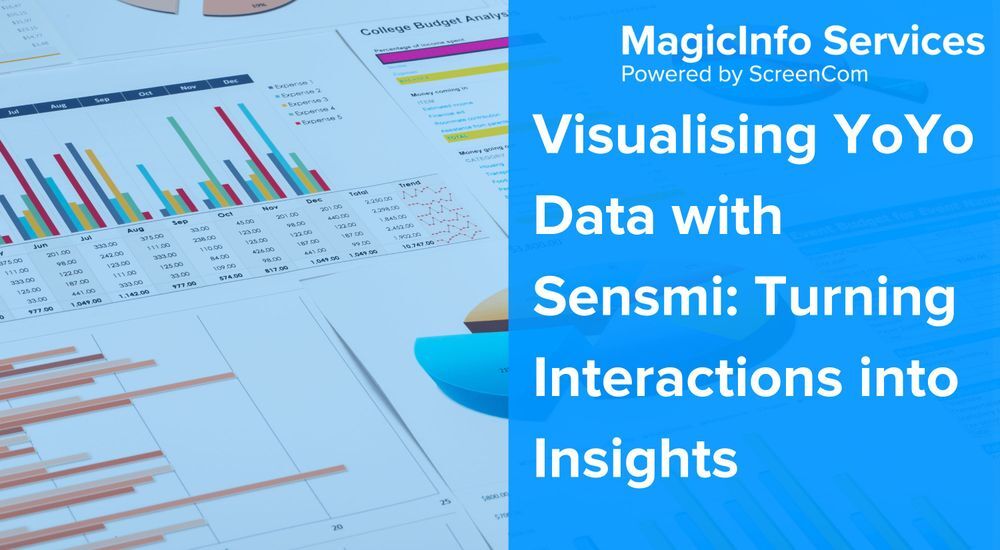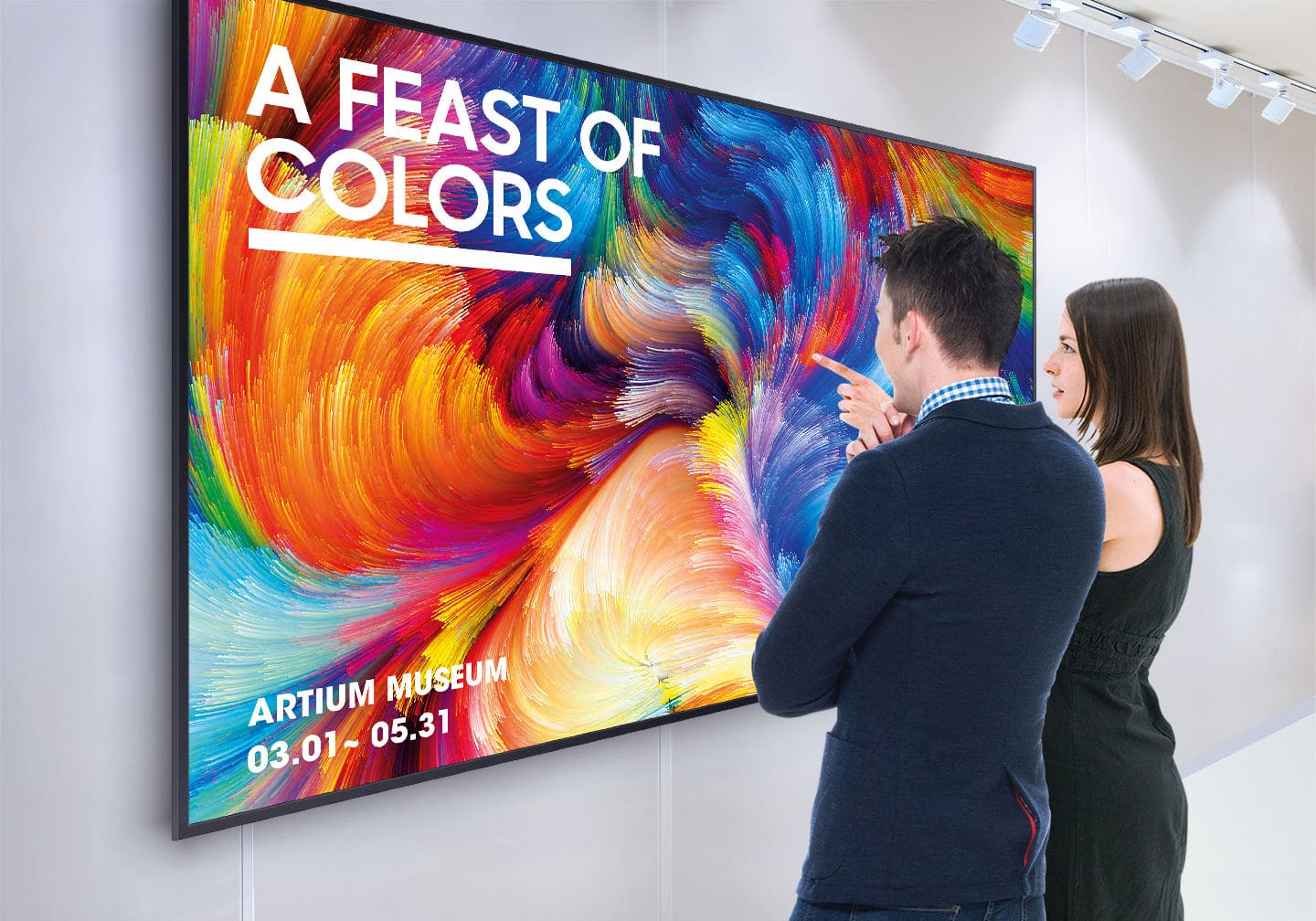The Samsung Digital Signage Hardware Guide
- Chapter I: What Are Digital Signage Displays?
- Chapter II: How Many Types of Digital Signage Displays Are There and What Are They Used for?
- Chapter III: How To Choose the Right Digital Signage Display for Your Business Needs
- Chapter IV: Integrating Samsung Digital Signage Hardware with Software Solutions
- Chapter V: Maintenance and Troubleshooting
- Chapter VI: Conclusion
What Are Digital Signage Displays?
Digital signage displays are devices specifically designed to display content for extended periods of time. They come in a variety of sizes and types, which makes it easy for anyone to find a suitable option. There are many reasons why you should consider choosing digital signage displays. We listed the top 4 below.
4. Screen Brightness
One of the first reasons why we see more and more digital signage displays incorporated into different spaces is because they offer sleek image quality due to the higher brightness of the displays. Compared to traditional consumer displays, which usually have a luminosity of 200-300 nit, digital signage displays have a light output of 350 nit up to several thousand nit.
Let's make this easier to understand. A nit is the unit of measurement for candela per square meter. An average candle flame produces 1 nit when it is spread evenly over a square meter. A digital signage display has the power of several hundred of these candles.
3. The Lifespan of Signage Displays
A second reason why digital signage displays are a great choice is that they have a higher lifespan than traditional consumer displays, lasting up to 50 thousand hours.
Are you wondering when do you need to replace your display? Our team has compiled a list of 3 signs to watch out for. The first thing you'll need to check is how many hours your TV has been switched on. Let's do a simple calculation. Suppose you are using the timer option available with your signage software, turning them on for 8 hours/day, 5 days/week. For a whole year, this would mean that your signage display has been on for 2080 hours. If you take into account what was mentioned above and divide the 50 thousand by this number, you'll discover your display should last you approximately 19 years. Talk about ROI!
The second thing to watch out for is the player version. If you're using Samsung displays, the player comes integrated into the display. This is also something you need to check when purchasing your display. In this case, you should look into whether there are any updates available for the player and whether these updates are compatible with your MagicINFO version.
Finally, there is a third thing to bear in mind. Sadly, this is usually the thing that most customers wait for to happen before investing in new hardware: drops in image quality, unexpected errors, or publishing issues with no apparent cause. Ideally, you want to prevent this from happening. By keeping track of the first two signs, you can prevent the third from happening.
2. Functionality
Another good reason why we see more and more digital signage displays is that these devices have lots of functionalities such as touchscreen options, that can be used effectively to attract audiences and allow them to interact with any content item you wish to display.
Furthermore, digital signage displays can be used both in portrait and landscape mode, which is not possible with a consumer display. Are you wondering whether to use landscape or portrait mode on your devices? Check out this article where we dive into different use cases for either mode. To put it briefly, portrait mode is great for showing longer-sized items such as menus for QSR. Landscape mode is useful for showing broader products such as shoes, bags, and so on.
Signage displays are made to be viewed from multiple angles, making sure your content can be seen straight on, or from an angled view. Also, there is no need to worry about the effect of sunlight because signage displays are not affected by this. In fact, they are specifically built to withstand lots of varied weather conditions.
1. Sustainable Choice
Moving on, in this day and age sustainability is a topic that is on everyone's lips. This brings us to one of the most important reasons why signage displays are a great option: they are a more sustainable choice compared to consumer displays. By replacing traditional pinboards with a digital solution, you can reduce CO2 emissions and save trees and water. Moreover, if you opt for a Samsung display, you can purchase the Remote Management solution, which allows you to control your signage installation remotely, thus reducing the time you'd spend traveling to the location of your display to fix any publishing issues, for instance. This will reduce the time and the CO2 emissions since your team does not need to travel to reach the displays.
For more information about the sustainability of digital signage, consider checking out this expert guide where we offer in-depth information about this topic.
How Many Types of Displays Are There and What Are They Used For?
Let's dive into the many different display options you can choose from. Depending on your goals with digital signage and your business needs, you can choose from the following:
- LCD/LED displays
- Interactive displays
- Video walls
- LED walls
- Digital signage Kiosk
You can find more information about the different digital signage display options for your business available from Samsung by checking out their website.
LCD/LED Displays
The most popular options in the industry by far are the LED (Light-Emitting Diode) and LCD (Liquid Crystal Display) screens. The main difference between these two technologies is in the backlights. While a standard LCD monitor uses fluorescent backlights, an LED monitor uses light-emitting diodes for backlights. LED monitors usually have superior picture quality,but they come in varying backlight configurations. And some backlight configurations create better images than others.
All LED displays are LCD, but not all LCD screens are LED, kind of like how all dolphins are mammals, but not all mammals are dolphins.
Interactive Displays
As we briefly mentioned before, interactive displays are a great choice if your goals with digital signage include increasing customer engagement. This is because this technology can be used to allow your customers to explore your selection of products on their own time, giving the impression of autonomy. Popular uses of this tech can be found in the retail, QSR, and automotive industries. If you're looking for ways to create a luxurious customer experience with digital signage, here are 6 ways you can achieve this.
Video Walls
Video walls are another popular option in the digital signage industry. This is because they are a versatile option. You can use video walls as a whole, creating one massive display, split it into multiple different screens, or you can create your own art wall. It's all up to your imagination. It is important to note that video walls are designed for indoor usage specifically. If your digital signage project includes outdoor displays, LED walls are a more suitable option.
Check out this blog for more information about the benefits of having a video wall installed and versatile video wall uses.
.png?width=2000&height=1000&name=video%20wall%20(2).png)
LED Walls
You might be asking yourself: what is an LED wall? Is it any different than a video wall? The answer is a loud and clear YES! LED walls are made of multiple LED panels, which can be customized by technicians to create a larger wall. You can create your own resolution by adding the LED panels the way you want them to. Contrary to video walls,
LED walls are a nice option when the location of the displays is a little further and when the content you'd like to show should be seen from a variety of angles. Also, LED walls have higher brightness and are better suited for outdoor applications.
Ultimately, when choosing between a video wall and an LED wall, it all comes down to the costs. Video walls are generally less expensive to install than LED walls. However, they have a longer shelf life of 5-10 years than video walls, whose shelf life is usually 3-5 years. For more information about what resolution you need for your displays and LED walls check out our blog covering this topic.
Digital Signage Kiosk
Last but not least, digital signage kiosk displays are also seen more and more often nowadays. These displays are designed with intuitive interfaces that allow users to manage the kiosk application. Samsung kiosk comes in 1 standard size of 24 inches.
One advantage of using digital signage kiosks is that they can be equipped with touchscreens or other interactive features, allowing customers to engage with the content and products in real-time. This can be particularly effective for businesses looking to provide self-service options, such as in-store ordering or product information displays.
When it comes to creating content for digital signage kiosks, keep in mind that a Kiosk app has to be created. In addition to this, a Remote Management license or cloud subscription is needed to connect a Kiosk display, which allows only hardware control.
.avif)
Digital signage projects are really not that different from any project. We, at MagicInfo Services by ScreenCom have written quite a lot about how to successfully introduce digital signage into your business. It all starts with getting buy-in from your team in order to receive the right support. You can use the article linked above to think about all the different aspects of such a project from creating your business plan to assembling the dream team.
Digital signage player or system on a chip?- the benefits of a built-in player
Depending on which hardware solution you will opt for your signage project, you might need to purchase an external player or not. The biggest advantage of Samsung hardware is that you don't need an external player as their hardware comes with a built-in player that works on an SoC (System on a Chip). Opting for this can save you quite a lot of money, especially if your installation requires a high number of displays. For example, if your installation has more than 100 screens you can save approximately 25% of your budget.
Another really good reason why go for a built-in player is that it looks more aesthetically pleasing to the eye since you'll get rid of all those annoying cables that can make the installation look quite messy.
S player
Samsung's hardware can be used in combination with the following player types: S player, I player, and W player. Arguably, the most popular option is the S player, more specifically, the S6 player, which can be found in many different displays. Moreover, this player is compatible with older versions of MagicINFO such as version 7. However, as newer technology is released, the player versions receive important updates, allowing you to schedule and display content at an even faster rate. With the release of the 9th version, MagicINFO offers complete compatibility with the S10 and I player devices, further expanding its range of supported hardware.
I player & W player
In some cases, you may prefer to use an external player, like a Windows computer, to display content. The I player enables you to do this and provides faster content display compared to the integrated S player, as it has higher RAM storage. For a detailed comparison between the I and S player types, refer to this blog. Alternatively, you can check out this other blog to compare the S6 and S10 player types. A small note that needs to be made is that consumer line displays are not compatible with MagicINFO and the SBB player, only with the I player.
For step-by-step instructions on how to install and create content for the I player you can watch the YouTube video below. Make sure to subscribe to our YouTube channel, MagicInfo Services, if you haven't already done so. We regularly upload content showing how to use MagicINFO to make the most out of your digital signage projects.
Upon the release of the 8th version of MagicINFO, Samsung launched new functionalities such as the W player, that can be used to create more dynamic content. Below you can find more information about the features of the W player.
Considering the physical environment: indoor/outdoor signage
An important thing to keep in mind when designing your digital signage project is whether your displays will be located indoors or outdoors. This is because digital signage indoor and outdoor displays cater to different environments and usage requirements.
Indoor displays, such as those from Samsung's Smart Signage lineup, are designed with high-resolution screens, energy-efficient technology, and robust builds to provide clear and vibrant visuals in controlled environments like retail stores, restaurants, and corporate settings. On the other hand, Samsung's outdoor displays are built to withstand a variety of weather conditions, featuring weather-resistant designs and higher brightness levels to ensure visibility even in direct sunlight. These outdoor displays are ideal for applications like outdoor advertising, public transit information, and event promotions.
Integrating Samsung Digital Signage Hardware with Software Solutions
When combining digital signage hardware with software solutions, you need to take into account the compatibility aspect. This is because, depending on the software solution chosen, it can maximize the system's performance and make it easier for you to maintain your signage installation. If you'd like to learn more about mastering digital signage with Samsung hardware and MagicINFO software integration, have a look at our blog covering this topic.
Samsung MagicINFO integration
If you opt for Samsung hardware, your best option is to combine it with MagicINFO, the software solution for digital signage produced by Samsung. MagicINFO is a powerful software solution designed to be compatible with Samsung displays. This means that you can count on a comprehensive range of features tailored to these devices as well as a reliable and efficient option for those looking to capitalize on the strengths of Samsung hardware.
In addition to this, MagicINFO is a highly versatile solution that is available both with on-premise installation and as a cloud solution. Should you opt for the on-premise option, MagicINFO requires a license in order to function. There are three types of MagicINFO licenses to choose from: MagicINFO Premium, Lite, or Remote Management. The same goes for the MagicINFO cloud solution. In general, we recommend MagicINFO Lite to customers who have no use for the extensive functionalities that come with MagicINFO Premium such as the Web Author, where you can create content and different templates, take full advantage of the Remote Management solution, and create smart playlists. For an in-depth overview of the differences between MagicINFO Lite and Premium, check out this blog.
Remote Management and CMS options in combination with your SSSP solution
As it was just mentioned above, MagicINFO can be used as a Remote Management standalone solution, which allows you to control and manage your signage installation from a distance. Thus, not only can you save time, money, and energy, and be more sustainable, but also more practical. Remote Management works similarly to any physical remote, only instead of using one, you'll be managing your content via the software.
With this solution, businesses can take full control over connected devices and manage a full range of Samsung hardware from a remote location. Samsung Remote Management is compatible with a full range of Samsung devices with a MagicINFO S-player. The combination of Samsung hardware and software allows for in-depth hardware control. Samsung Remote Management works on S4 players and higher.
If you're curious about how to use Remote Management with any SSSP application, check out the YouTube video below.
Maintenance and Troubleshooting
Once you have the digital signage installation ready, you might fall into the trap of thinking the job is over. It's really not. Someone in the team should be assigned to constantly monitor the installation, making sure the content runs smoothly according to the set schedule, and there are no strange errors. Ideally, this person has enough technical knowledge and can handle all sorts of errors that might occur. Below we'll share some useful tips hardware optimization tips.
Routine maintenance tips
The first tip, and the most important one is to always make sure there is content shown on the displays. You can set your own default content thus avoiding the scenario where your displays will be showing the MagicINFO logo instead of something you created yourself.
Furthermore, if the screens are located in a place where the internet connection is not stable, you can make use of the advanced backup play option. This feature allows you to set a display as a backup screen or main screen depending on the importance of the content. Previously, the backup screen automatically plays a vital content item if the content source of the main screen encounters any issues such as an error or no signal. With this Advanced Backup Play feature, the backup screen can not only play the main content but also play its original content (toggle) depending on the settings. So when one display has an error, the display set as a backup will take over the information that was shown on the displays with an error.
Another very important tip is to monitor your installation to avoid having black screens at your location. You have to be sure that your displays are all switched on and online. When you log in to MagicINFO you can find an overview of your devices but also the dashboard provides a report with the device status. Because you have to log in first, set up a notification email so you get notified if a screen has been switched off. This will help you monitor your devices proactively which helps you to anticipate errors quicker.
Finally, it's worth mentioning that, while creating content through the Web Author and publishing it is the easiest way to display content, there are other alternatives. You can read about 3 other ways to broadcast signage content on your displays with MagicINFO in this blog post. Learn how to stream your IPTV directly on the SOC, how to connect a tuner to HDMI, and how to use the channels option in MagicINFO.
Conclusion
There are many things to consider when learning about digital signage, both from the hardware and software perspectives. By reading this expert guide, you learned about digital signage displays and 4 reasons why to choose them over consumer displays, the types of Samsung digital signage hardware available and their different uses, how to integrate your hardware with the software solution of your choice, with a focus on MagicINFO as a digital signage solution, and some useful tips for routine maintenance.
You have reached the end of our expert guide. For more information on how to use digital signage and MagicINFO to level up your project schedule a meeting with one of our MagicINFO experts. If you like our YouTube videos, make sure to subscribe to our YouTube channel if you haven't already done so. We regularly upload content showing how to use MagicINFO to make the most out of your digital signage projects.
Contributors:

Evelyn Lok
Senior Marketing Specialist

Radost Hristova
Marketing Specialist

Andreea Ardelean
Marketing Trainee
From Our Blog
Stay up to date with what is new in our industry, learn more about the upcoming products and events.
.png)
YoYo V3: Easier, Hardware-Free Digital Signage Management

Visualising YoYo Data with Sensmi: Turning Interactions into Insights
.png)

